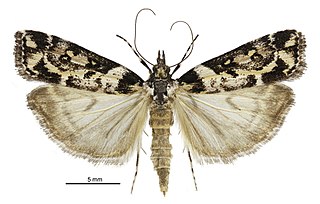
Eudonia diphtheralis is a species of moth in the family Crambidae. It is endemic to New Zealand.
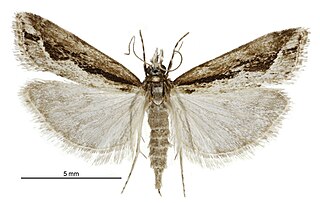
Eudonia steropaea is a species of moth of the family Crambidae. It was named by Edward Meyrick in 1884. Meyrick gave a detailed description of this species in 1885. It is endemic to New Zealand.

Heterocrossa gonosemana is a species of moth in the family Carposinidae. It is endemic to New Zealand and is found throughout the country. It inhabits native forest. Larvae feed on seeds and fruit of Griselinia lucida and possibly Griselinia littoralis. They can be extremely active when disturbed. This species overwinters as a pupa, enclosed in a cocoon, underneath its host plant. Adults are on the wing from November until February and can be found during the day resting on lichen covered tree trunks where they are well camouflaged. The adult is nocturnal and is attracted to light.

Pyroderces aellotricha, also known as the Cosmet moth, is a moth of the family Cosmopterigidae. It is found in New Zealand, in Australia and the Cook Islands.
Petasactis is a genus of moths belonging to the family Tineidae. It contains only one species, Petasactis technica, which is endemic to New Zealand. This species has not been collected since prior to 1888. It is classified as "Data Deficient" by the Department of Conservation.

Ichneutica omoplaca is a moth of the family Noctuidae. It is endemic to New Zealand. It is widespread from the Bay of Plenty in the North Island down to Southland in the South Island. Specimens have also been collected from the Auckland Islands. It lives in a variety of habitats including beech forest clearings and tussock grasslands. This species has been recorded that some of the larval hosts of this species include Poa cita, Dactylis glomerata and it has been reared on Plantago lanceolata. The larva is undescribed but pupae have been found in a pine plantation in soil under weeds. Adults of this species are on the wing from October to March. The adult moths are variable in appearance but the diagnostic feature is the pale ochreous to white colouring between the basal streak and the costa which contrasts with the ground colour of the forewing.

Scoparia nomeutis is a moth in the family Crambidae. It was named by Edward Meyrick in 1884. Meyrick gave a description of this species in 1885. It is endemic to New Zealand.

Scoparia petrina is a species of moth in the family Crambidae. It was named by Edward Meyrick in 1884. Meyrick gave a description of the species in 1885. It is endemic to New Zealand.
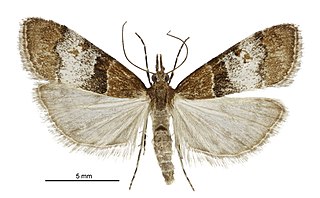
Antiscopa acompa is a moth in the family Crambidae. It was first described by Edward Meyrick in 1884. It is endemic to New Zealand and is found both the North and South Islands. The species inhabits native forest and adult moths are attracted to light.
Eudonia homala is a moth in the family Crambidae. It was described by Edward Meyrick in 1885. It is found in Australia, where it has been recorded from South Australia.

Eudonia legnota is a moth in the family Crambidae. This species was named by Edward Meyrick in 1884. It is endemic to New Zealand.
Eudonia perierga is a moth in the family Crambidae. It was described by Edward Meyrick in 1885. It is found in Australia, where it has been recorded from Tasmania.

Eudonia periphanes is a moth in the family Crambidae. It was named by Edward Meyrick in 1884. Meyrick gave a detailed description of this species in 1885. It is endemic to New Zealand.

Eudonia philetaera is a moth in the family Crambidae. It was named by Edward Meyrick in 1884. Meyrick gave a description of the adult moth in 1885. It is endemic to New Zealand.
Eudonia exilis is a moth in the family Crambidae. It was described by Henry Guard Knaggs in 1867. It is found in New Zealand.
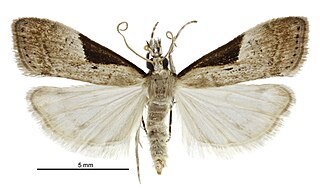
Eudonia pongalis is a moth in the family Crambidae. It was described by Cajetan Felder, Rudolf Felder and Alois Friedrich Rogenhofer in 1875. It is endemic to New Zealand.

Austrocidaria lithurga is a species of moth in the family Geometridae. It is endemic to New Zealand. This moth is classified as at risk, naturally uncommon by the Department of Conservation.

Ichneutica paracausta is a moth of the family Noctuidae. This species is endemic to New Zealand. It is found locally in the central North Island, is widespread in the South Island and can also be found in Stewart Island. I. paracausta is variable in colour, but as it has a distinctive black streak on its forewing as well as a wing pattern that is characteristic, I. paracausta is unlikely to be confused with other species. It is present on the North Island volcanic plateau as well as Little Bush Reserve in Hawkes Bay in the North Island as well as in tussock grassland, alpine and subalpine shrubland and in alpine forest. Larvae have been recorded as feeding on grasses, a pupa has been found in a cocoon under the bark of a tree and adult moths are on the wing from October to January.
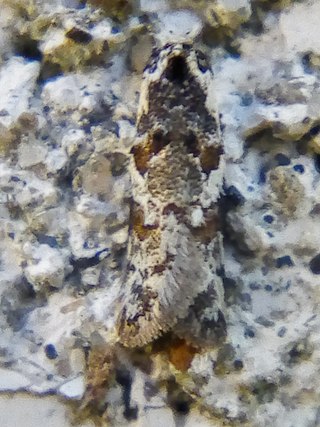
Trachypepla galaxias is a moth of the family Oecophoridae first described by Edward Meyrick in 1883. It is endemic to New Zealand and can be found throughout the country. This species inhabits native forest. The life history of this species is currently unknown. Adults are on the wing from October to February, are nocturnal and are attracted to light.

Trachypepla protochlora is a moth of the family Oecophoridae first described by Edward Meyrick in 1883. It is endemic to New Zealand and is found in both the North and South Islands. The preferred habitat of this species is native forest and adults are on the wing from October until February. Adults can be variable in their green shaded colour as well as in the intensity of markings on their forewings. The greenish ground colouration of this moth ensures they are well camouflaged when at rest on green mosses and lichens.















